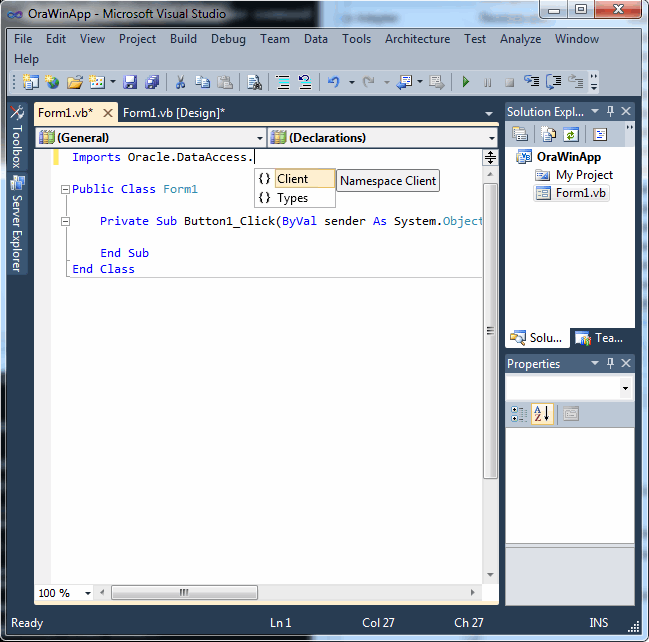- Install Oracle Dataaccess Client
- Oracle Dataaccess Client
- Oracle Dataaccess X64
- Oracle Dataaccess Client Is Not Installed Visual Studio
- Oracle Data Access Client Is Not Installed Enough
- Oracle.dataaccess.client.oracleconnectionstringbuilder Type Is Not Found
- The Oracle Data Access Client is not installed. Sign In: To view full details, sign in with your My Oracle Support account.
- If you install Oracle Database Client on a computer with no other Oracle software installed, Oracle Universal Installer creates an Oracle base directory for you. If Oracle software is already installed, one or more Oracle base directories already exist.
- A messagebox/error appears stating The recommended provider('Oracle.DataAccess.Client') is not installed. You can continue with your current provider, however.
Last updated on OCTOBER 03, 2019
Applies to:
Hyperion Planning - Version 11.1.2.0.00 and laterOracle.DataAccess does not appear because it is an 64bit assembly but your Visual Studio is 32bit. There are several solutions: In Add References use the Browse section and locate Oracle.DataAccess.dll manually. Typically you will find it in folder%ORACLEHOME% odp.net bin 2.x or%ORACLEHOME% odp.net bin 4. 'The recommended provider ('Oracle.DataAccess.Client') is not installed. You can continue with your current provider, however it has been deprecated and may not work properly.' I click on 'Learn more' hyperlink which led me to this document page.
Information in this document applies to any platform.
Symptoms
When attempting to perform a database configuration for Enterprise Performance Management Architect (EPMA) using the EPM System Configurator, the following error occurs:
The Oracle Data Access Client is not installed.
Cause
To view full details, sign in with your My Oracle Support account. |
Don't have a My Oracle Support account? Click to get started! |

| Symptoms |
| Cause |
| Solution |
Oracle Data Provider for .NET is part of Oracle Data Access Components (ODAC), which can be downloaded from OTN. Beginning with ODAC 11.1.0.6.20, Oracle Data Provider for .NET can be installed through XCopy or Oracle Universal Installer.
XCopy
Administrators use XCopy to deploy Oracle Data Provider for .NET to large numbers of computers for production deployments. The XCopy has a smaller installation size and fine-grain control during installation and configuration than Oracle Universal Installer.
Oracle Universal Installer (OUI)
Developers and administrators use Oracle Universal Installer for automated ODP.NET installations. It includes documentation and code samples that are not part of the XCopy.
Note:
This section describes installation using the Oracle Universal Installer. For installation and configuration using the XCopy install, refer to the README.TXT file that is part of the XCopy installation.Additionally, Oracle Data Provider for .NET Dynamic Help is registered with Visual Studio, providing context-sensitive online help that is seamlessly integrated with Visual Studio Dynamic Help. With Dynamic Help, the user can access ODP.NET documentation within the Visual Studio IDE by placing the cursor on an ODP.NET keyword and pressing the F1 function key.
Oracle Data Provider for .NET creates an entry in the machine.config file of the computer on which it is installed, for applications using ADO.NET 2.0 and OracleClientFactory class. This enables the DbProviderFactories class to recognize ODP.NET.
See Also:
 Oracle Database Installation Guide for Windows for installation instructions
Oracle Database Installation Guide for Windows for installation instructionsFile Locations After Installation
Fluidsim hidraulica portable. The Oracle.DataAccess.dll assembly is installed to the following locations:
.NET Framework 2.0:
ORACLE_BASEORACLE_HOMEodp.netbin2.x directory
.NET Framework 4:
ORACLE_BASEORACLE_HOMEodp.netbin4 directory
Note:
If the machine has the corresponding .NET Framework installed, then theOracle.DataAccess.dll assembly is added to the Global Assembly Cache (GAC) as well. This is to ensure that existing applications can start using the newly installed ODP.NET version immediately. However, if this is not desired, be sure to remove the policy DLLs from the GAC.
Documentation and the readme.txt file are installed in the ORACLE_BASEORACLE_HOMEODP.NETdoc directory.
Samples are provided in the ORACLE_BASEORACLE_HOMEODP.NETSamples directory.
Search Order for Unmanaged DLLs
ODP.NET consists of managed and unmanaged binaries. Through the use of the DllPath configuration parameter, each application can specify the ORACLE_BASEORACLE_HOMEbin location that the dependent unmanaged Oracle Client binaries are loaded from. However, the ORACLE_BASEORACLE_HOME must have the same ODP.NET version installed as the version that the application uses. Otherwise, a version mismatch exception is thrown.
The Oracle.DataAccess.dll searches for dependent unmanaged DLLs (such as Oracle Client) based on the following order:
Directory of the application or executable.
DllPathsetting specified by application config orweb.config.DllPathsetting specified bymachine.config.DllPathsetting specified by the Windows Registry.HKEY_LOCAL_MACHINESoftwareOracleODP.NETversionDllPathDirectories specified by the Windows
PATHenvironment variable.
Upon installation of ODP.NET, Oracle Universal Installer sets the DllPath Windows Registry value to the ORACLE_BASEORACLE_HOMEbin directory where the corresponding dependent DLLs are installed. Developers must provide this configuration information on an application-by-application basis.
When a new ODP.NET version is installed, default values are set in the Windows Registry for the new version. Because the policy DLLs redirect all ODP.NET references to this new ODP.NET version, applications use the default values. Developers can provide a config or web.config file specific to the application to prevent this redirection. The configuration file settings always apply to the application, regardless of whether or not patches or new versions are installed later.
ODP.NET Configuration File Support is only available for version 10.2.0.4 and later.
Note:
Install Oracle Dataaccess Client
BothOracle.DataAccess.dllOracle Dataaccess Client
for .NET Framework 2.0 and
Oracle Dataaccess X64
Oracle.DataAccess.dll for .NET Framework 4 use the same unmanaged DLL, OraOps11w.dllOracle Dataaccess Client Is Not Installed Visual Studio
.Oracle Data Access Client Is Not Installed Enough
ODP.NET and Dependent Unmanaged DLL Mismatch
Oracle.dataaccess.client.oracleconnectionstringbuilder Type Is Not Found
To enforce the usage of Oracle.DataAccess.dll assembly with the correct version of its unmanaged DLLs, an exception is raised if Oracle.DataAccess.dll notices it has loaded a mismatched version of a dependent unmanaged DLL.
